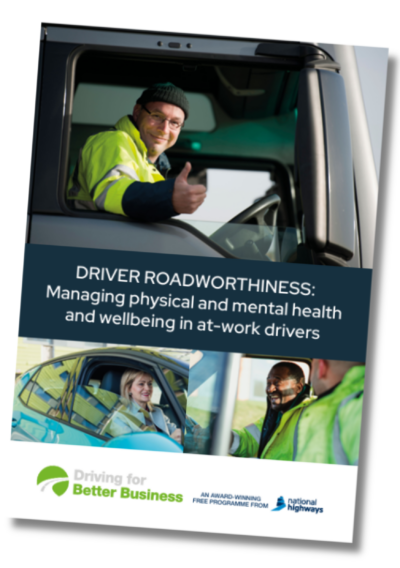Driver Roadworthiness: Managing physical and mental health & wellbeing in at-work drivers
Developed with industry experts, this guide emphasises the importance of not only ensuring vehicle roadworthiness, but also the fitness of drivers. It highlights that driver health, mental state, and physical fitness significantly impact driving safety. The guide provides strategies for assessing and maintaining driver roadworthiness.

Download the Driver Roadworthiness Guide
Managing physical and mental health & wellbeing in at-work drivers
Driver Roadworthiness:
Managing physical and mental health and wellbeing in at-work drivers
Organisations using vehicles for business usually invest a lot of time and effort into ensuring the roadworthiness of the vehicle – but do they spend enough time ensuring that their driver is fit to be behind the wheel?
Vehicle roadworthiness is essential, of course – but the fact remains that, in most cases, it is not vehicles which cause collisions but rather the human beings driving them.
Your driver’s physical health, state of mind and mental wellbeing has a profound effect upon their safety when driving. Driving requires sustained focus, situational awareness and sound, rational decision-making. Issues such as pain, fatigue, illness, stress and dehydration are likely to compromise a driver’s ability to maintain their attention on the road and to perform safely.
Investing in your drivers’ welfare will help you to fulfil your statutory duty of care, which includes protecting your employees from physical and emotional harm and protecting them and other road users from road risk. It will also bring substantial benefits to your organisation including:
- lowering your collision risk
- lowering vehicle damage, third party claims, insurance premiums and unexpected downtime
- higher productivity
- better staff retention, with lower absenteeism and presenteeism
- lower levels of sick leave
- a more engaged workforce
- brand and reputational enhancement and protection
This guide will show you how to assess and maintain driver roadworthiness, manage the potential problems drivers may face, and understand what you should do to make sure your drivers remain fit and focused behind the wheel. In doing so, you will lower your collision risk.
We have asked leading academics and relevant experts to be your guide to the various aspects of physical and mental health, as well as the culture of psychological safety you need so that people feel safe in voicing concerns. The guide covers:
- human factors
- physical illness and conditions
- mental health
- personal circumstances
- lifestyle factors
- driver screening and monitoring
- case studies and comparisons
- potential interventions
